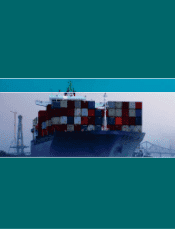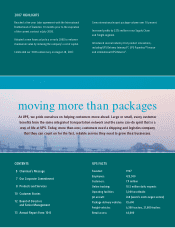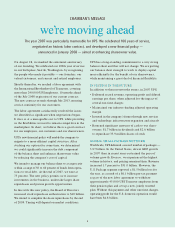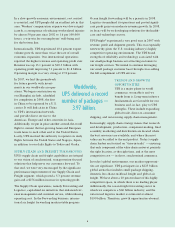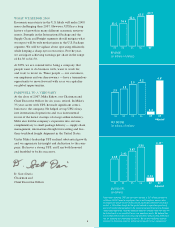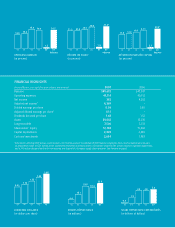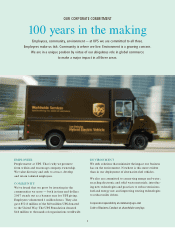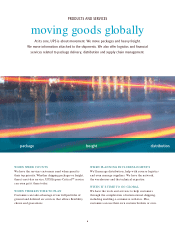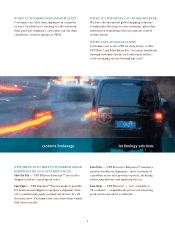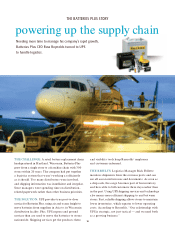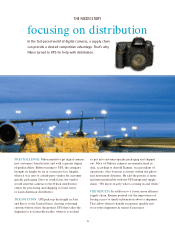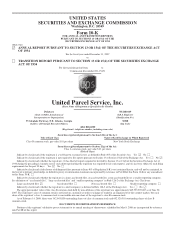UPS 2007 Annual Report Download - page 6
Download and view the complete annual report
Please find page 6 of the 2007 UPS annual report below. You can navigate through the pages in the report by either clicking on the pages listed below, or by using the keyword search tool below to find specific information within the annual report.
In a slow-growth economic environment, cost control
is essential, and UPS people did an excellent job in this
area. Workers’ compensation expense was down signif-
icantly, a consequence of reducing work-related injuries
by almost 50 percent since 2002 to 1.6 per 100,000
hours, a win-win for our employees’ well-being and
for the bottom line.
Internationally, UPS experienced 10.4 percent export
volume growth, more than twice the rate of overall
economic expansion. O ur international operations
reported the highest revenue and operating profi t ever.
Revenue was up 13.1 percent to $10.3 billion with
operating profi t improving 7.1 percent to $1.8 billion.
O perating margin was very strong at 17.8 percent.
In 2007, we laid the groundwork
for future growth with invest-
ments in our worldwide air oper-
ations. We began construction on
our Shanghai air hub, scheduled
for completion in 2008, the fi rst
in China to be operated by a U.S.
carrier. It will link cities in China
to UPS’s international network,
and provide direct service to the
Americas, Europe and other countries in Asia.
Additionally, we put in place another around-the-world
fl ight to connect the fast-growing Asian and European
trade lanes to each other and to the United States.
Lastly, UPS received the authority to operate six daily
fl ights between the United States and Nagoya, Japan,
in addition to our daily fl ights to Tokyo and O saka.
SUPPLY CH AIN AN D FREIGH T TURN AROUN D
UPS’s supply chain and freight capabilities are integral
to our vision of synchronized, transportation-focused
solutions that help move our customers forward. To
that end, we were very encouraged by the signifi cant
performance improvement of our Supply Chain and
Freight segment, which posted a 5.3 percent revenue
gain and a $276 million increase in operating profi t.
The Supply Chain operations, namely Forwarding and
Logistics, capitalized on initiatives that enhanced rev-
enue management and customer service, while reducing
operating cost. In the Forwarding business, interna-
tional air freight forwarding made notable progress.
O cean freight forwarding will be a priority in 2008.
Logistics streamlined its operations and posted signifi -
cant profi t gains on moderate revenue growth. In 2008,
its focus will be on developing solutions for the health-
care and technology sectors.
UPS Freight® experienced a very good year in 2007 with
revenue, profi t and shipment growth. This was especially
noteworthy given the U.S. trucking industry’s highly
competitive operating environment. The UPS brand
strengths of reliability and technology associated with
our small package business are attracting customers to
our freight services. We intend to continue leveraging
our small package customer base through cross-selling
the full complement of UPS services.
TR EN DS AN D GROW T H
OPPO RTUN ITIES
UPS is a major player in world
commerce; we enable it and we
benefi t from it. Long-term industry
fundamentals are favorable for our
business and, in fact, play to UPS
strengths. These include expanding
global trade, direct-to-consumer
shipping, and outsourcing supply chain management.
Increasingly, supply chain strategy means that research
and development, production, component-making, fi nal
assembly, marketing and distribution are located where
the best resources are available, and where the most
value can be added to the end product. Today’s supply
chain leaders are focused on “time-in-trade” — ensuring
that each component of the value chain arrives at precisely
the right location, at the right time, and at the most
competitive cost — in short, synchronized commerce.
In today’s global environment, our market opportuni-
ties are signifi cant. UPS participates in a $225 billion
global arena that includes small package shipping,
domestic less-than-truckload freight and global air
freight. We have about a 20 percent share of this highly
competitive space, in which there is no leading player.
Additionally, the ocean freight forwarding sector in
which we compete is a $60 billion industry, and the
outsourced logistics market is estimated at almost
$190 billion. Therefore, growth opportunities abound.
4
Worldwide,
UPS delivered a record
number of packages —
3.97 billion.


